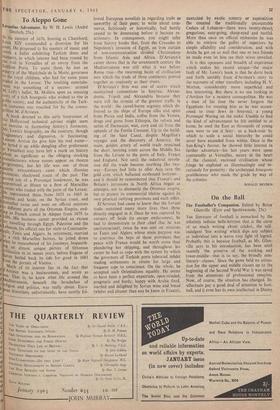On the Ball
The Footballer's Companion. Edited by Brian Glanville. (Eyre and Spottiswoode, 25s:) THE literature of football is unmarked by the infinitely tedious belle-lettrism that is the curse of so much writing about cricket, the self- indulgent 'fine writing' which dips any subject or individual into a warm rosy light of legend. Probably this is because football, as Mr. Glan- ville says in his introduction, has been until recently 'the preserve of the working and lower-middle—that is to say, the broadly non- literary—classes.' Since the game held no attrac- tion for the upper and middle classes up to the beginning of the Second World War it was saved from the attentions of professional essayists. Now, of course, the situation has changed. In- tellectuals pay a good deal of attention to foot- ball, and it even has its own intellectual in Danny Bianchi'lower, but the crowds on the terraces diminish.
The effect of this historical development has been to make football literature rather agree- ably lop-sided. This collection contains some fascinating turn-of-the-century pieces about the great amateurs, G. 0. Smith, W. N. Cobbold, Vivian Woodward. After that, there is a period of dearth until the end of the Second World War. Since then, football literature has been more accurate and less frilly than cricket litera- ture. In consequence, our view of the giants, and the historic matches, in the period before and after the First World War is necessarily very limited. There is an excellent article about Billy Meredith, and a couple of pages about Steve Bloomer, but these have both been written in the last decade. And Alex James, Warney Cresswell, Hughie Gallacher, where are they? Mentioned only incidentally, or not at all. This is no criticism of Mr. Glanville, who has done a splendid job, but an indication of the limits of the literature.
What he does offer, to any enthusiast, is rich enough. The fiction is feeble, like cricket fiction —the best stories here are Mr. Glanville's own. But the actualities, as technicians call them, are magnificent. I should have liked to see the huge Alfred Lyttelton, the first double international at soccer and cricket, who when charged simul- taneously would send the chargers 'rebounding on to their backs,' dissolving afterwards 'into a loud, merry laugh, in which the prostrate victim not infrequently joined.' Or for that matter W. N. Cobbold. who 'sent the ball in like a charge from a hundred-ton gun,' or Archie Hunter who 'when apparently circum- vented, would turn round and keep the man off with his hindquarters.' There is an echo of Archie Hunter in George Scott's account of Middlesbrough's centre-forward of the Thirties, George Camsell, who would work his way to- wards the opposition goal 'with a vigorous wriggling of his buttocks and an ungentlemanly mobility of elbows, arms and bottom working hard to throw off his escort.'
The accounts of modern players, from Raich Carter to Tommy Harmer, and of matches, from Cliff Bastin's vivid picture of an Arsenal Cup defeat in the Thirties onwards, are of almost uniform excellence, and the sections on goal- keepers, famous clubs. and on past battles— some recollected in tranquillity by participants —are all admirable, If only England's foot- ballers at the moment were as good as the people who write about them, we should cer- tainly be world champions.
JULIAN SYMONS































 Previous page
Previous page